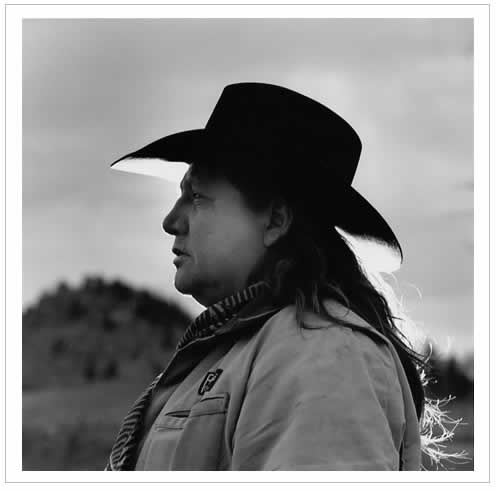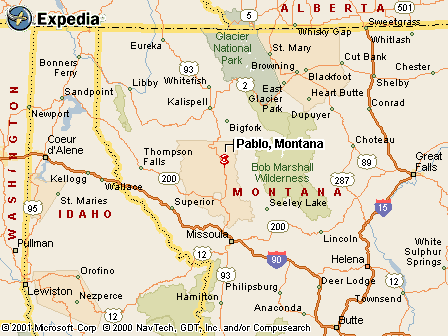|
|
Canku Ota |
|
|
(Many Paths) |
||
|
An Online Newsletter Celebrating Native America |
||
|
May 1, 2004 - Issue 112 |
||
|
|
||
|
Indian Writers Bring Literature to Life for Students in Pablo |
||
|
by John Stromnes of
the Missoulian
|
||
|
credits: photo:
Henry Real Bird
|
|
Right out of the gate, Henry Real Bird, a 55-year-old Indian poet and rancher from the Crow Reservation, closed his eyes tight, thrust his arms toward the sky and shouted out a long, long line from one of his "cowboy" poems to a group of wide-eyed, 11th-grade students. The silver conchos on Real Bird's belt gleamed in the morning sunlight; his black ponytail reached almost to his waist, and his yellow shirt had the top two buttons open at the throat. "I'm the feeling morning after yesterday just before the sun a little beyond nothing on this side of everything dreaming of a feeling on a dream ..." "It's beautiful to daydream," he then told the students. "You've got to have something to say. I'm not really in love with this world as it is, but this world is where I live." Real Bird's visit was part of Monday's Celebration of Native American Literature at Two Eagle River School. Right after lunch, right there in the lunchroom, Debra Magpie Earling, 46, the award-winning Salish novelist of "Perma Red," stood erect and stock still, only her lips moving, her voice a clear drone. She read a long, disturbing and violent passage from her second novel (still not published and as yet untitled) involving the stabbing and dismemberment of an Indian warrior woman. Two students came up to her afterward in tears, so affected were they by the power of the words. There was, of course, some time for teaching - traditional teaching. David Moore, a University of Montana associate professor of English who specializes in American Indian literature, presented each of his students with a tidy, four-page study guide. He gathered each group of students in a standing circle, and asked them to read aloud poems of Indian writers. Each student read one line at a time, clockwise around the circle. The chattering stopped, and you could hear each voice distinctly as the students took turns. First, the students read from Joy Harjo's "Eagle Poem" published as an audiotape and CD. To
pray you open your whole self After this initial reading, Moore asked the students questions: "Did you notice when we started reading, the room grew quiet and the poem became more powerful? Did you ever think of the eagle as a model of how to behave? You can open up the self like the eagle opening its wings. There you are, soaring, a circle of motion. We can take (the image) with us into everyday life." More disturbing was the next selection, an excerpt from the book-length poem, "From Sand Creek." The book is a reflection in verse by Acoma Pueblo poet Simon Ortiz on the unprovoked 1864 Sand Creek, Colo., massacre of a village of Cheyenne Indians by a militia of whites. This
America, "A terrible moment in American history," Moore concluded. But not an isolated one. He mentioned a less famous, but even bloodier massacre, closer to home - the so-called Baker Massacre on the Marias River in north-central Montana in 1870. About 200 Piegans, most of them either elderly or women and children, were killed by the relentless gunfire of U.S. government soldiers armed with the Army's new Springfield repeating rifles. It remains one of the least-known and least-told stories of American military history, according to some students of American Indian history. "How do these images offer different angles on America and history? What does it mean for an American Indian to tell America about America's own heart?" he asked his class. Many of the students seemed deeply affected by the readings and interaction with American Indian writers. "I'm getting interested in writing. I'm learning writing is easy," said Allie Burke, 15, of Ronan, after the dramatic lunchroom reading by Earling from her novel in progress. The daylong event was organized by Trent Atkins, assistant professor in the Department of Curriculum and Instruction at the UM. He said it was part of a program called TERRACE, which stands for Two Eagle and Ronan Reading Acceleration for Content Excellence. The program involves the Ronan School District, Two Eagle River School and the Native American Studies Department and the School of Education at UM. Teachers from the Ronan, Pablo and Two Eagle schools were also welcome at the workshop, and several joined the 60 Two Eagle students in sessions with the writers throughout the day. Also presenting were Rhea A. Ashmore, professor of literacy studies at UM, and Allison Hedge Coke, author of "Dog Road Woman," which won the American Book Award for poetry in 1998. |
|
|
www.expedia.com |
|
|
||
|
|
||
| Canku Ota is a free Newsletter celebrating Native America, its traditions and accomplishments . We do not provide subscriber or visitor names to anyone. Some articles presented in Canku Ota may contain copyright material. We have received appropriate permissions for republishing any articles. Material appearing here is distributed without profit or monetary gain to those who have expressed an interest. This is in accordance with Title 17 U.S.C. Section 107. | ||
|
Canku Ota is a copyright © 2000, 2001, 2002, 2003, 2004 of Vicki Lockard and Paul Barry. |
||
 |
 |
|
|
The "Canku Ota - A Newsletter Celebrating Native America" web site and its design is the |
||
|
Copyright © 1999, 2000, 2001, 2002, 2003, 2004 of Paul C. Barry. |
||
|
All Rights Reserved. |
||
 PABLO
- Monday was not your typical day at Two Eagle River School, the
grades 7-12 alternative tribal school in Pablo.
PABLO
- Monday was not your typical day at Two Eagle River School, the
grades 7-12 alternative tribal school in Pablo. 